| The Realm and Stage |
|
| |
| Palace of Schonbrunn |
| |
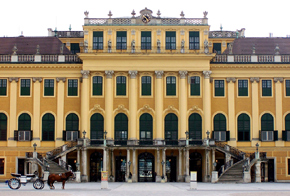
Schonbrunn was the former imperial palace in Vienna, built during the reigns of Emperor Charles VI and Maria Theresa. Mainly designed by Fischer von Erlach, it is a splendid example of Austrian baroque. It's beautiful park, emulating Versailles, has a large zoological and botanical garden.
This is where the young Maria Antoina lived in a world surrounded by her family and servants who adored her. She spent much of her time during the summers in the vast gardens that surrounded the royal palace. |
|
| |
 






|
|
| Le Petit Trianon |
| |
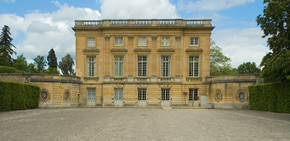
In 1761, Louis XV asked Ange-Jacques Gabriel to design a house for himself and Madame de Pompadour at the east end of the garden, which surrounded the French Pavilion of the Palace of Versailles. They called this house le Petit Trianon and Louis XIV's larger retreat became known as the Grand Trianon. The Petit Trianon was completed in 1768; by this time Madame de Pompadour had died. The king and his new mistress, Madame du Barry, enjoyed it until his death on May 10, 1774.
One of the first acts of the new king, Louis XVI, was to give the Petit Trianon to his wife, Marie Antoinette, who was nineteen years old. The new queen immediately expressed her desire to transform the botanical garden into the newest style of what we consider today to be a traditional English garden.
Marie Antoinette wanted an even more informal place, according to the last fashion. Visiting the Désert de Retz, she would have exclaimed, seeing the temple of the god Pan there, "But, it is a temple of Love!" She was continually lacking of affections from her husband, the King, who behaved opposite of that, spoiling her financially with every whim and desire, but ignored her ultimate desire of intimacy and the consummation of her marriage.
In 1768, Richard Mique built the Temple of Love, housing a former statue by Bouchardon "the Love cutting an arc in the bludgeon of Hercules" and the Belvédère, at the top of the upper lake. In that corner is the rock, including the Queen's grotto, which was designed by painter Hubert Robert, a ruins specialist. |
|
| |
 








|
|
| Le Petit Trianon's Hameau |
| |
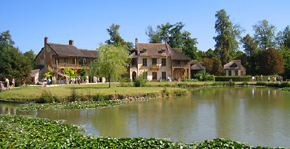
In 1782, the Queen commissioned the Hameau to be built at the edge of a pond, a quarter mile northeast of le Petit Trianon. One could describe the buildings as twelve small ornamental farmhouses. These farmhouses were rustically built and were designed to play perfectly that role in a small country village. At the east side of the pond are more game houses, an ornamental dairy and the tower of Marlborough, which is supposed to be a fishery that sits on the opposite bank. The farm itself is planted behind a working mill. Kitchen gardens extended between the hamlet and the ornamental dairy.
Marie Antoinette insisted that the buildings look as if they had always existed there, no matter the cost. She had a deep desire to live the life of a simple commoner, feeling that she had been miscast in the role as Queen. Her dream was to have built a "fantasy farm" where she could live simply without etiquette and the prying eyes of court. |
|
| |
 




|
|
| Tuileries Palace |
| |

Catherine de Medici, the widowed wife of Francis I, ordered the construction of the Palace des Tuileries just a few hundred yards in front of the existing chateau of the Louvre. The Queen Mother commissioned architects to build a passageway linking the Louvre and the Tuileries.
Catherine was very superstitious and believed avidly in mystics. While still in the flurry of planning and decorating, an astrologer eventually frightened her away from ever residing in the new lodgings. Her stay at the palace was abruptly interrupted when she learned that she would die near Saint-Germain. Since the Tuileries Palace was in the parish of the church Saint-Germain-Auxerrois, Catherine packed her bags, took her furniture and left. As history tells us, years later, on her deathbed at the royal chateau of Blois she received the last rites from Father Julien de Saint-Germain!
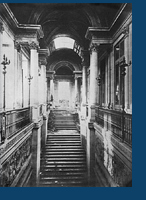 Even the name seemed to be an oddity. The reference to "tuiles" or roof tiles, which the factories produced for centuries, was located near the present site of the gardens. The great Louis XIV resided at the Tuileries Palace while his chateau, Versailles, was under construction. When he left, the building was abandoned, used only as a theater, until the return of the ill-fated royal family. Even the name seemed to be an oddity. The reference to "tuiles" or roof tiles, which the factories produced for centuries, was located near the present site of the gardens. The great Louis XIV resided at the Tuileries Palace while his chateau, Versailles, was under construction. When he left, the building was abandoned, used only as a theater, until the return of the ill-fated royal family.
On October 6, 1789, Louis XVI and his family were forcefully removed from Versailles and installed in the Tuileries Palace. Two years later, France's new legislative assembly decreed that the Louvre and the Tuileries would serve as a royal residence. The royal family attempted escape. They slipped out of the palace, disguised as servants, praying for release from this captivity and were only to be captured in Varennes, a town on the border of Germany where they were recognized by a peasant from the resemblance of Louis to his coin!
They were dragged back to the Tuileries, now under strict guard. The palace and the gardens were to be their universe until the most dramatic day of the French revolution, August 10, 1792, when the bells of Paris rang in every working class neighborhood and the people stormed the palace in anger.
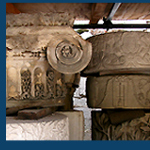 The royal family fled to the General Assembly hall near the Place de la Concorde. The faithful Swiss guards, loyal to the end, defended the palace, unaware that their royal charges had deserted the building. The rabble stormed the doors, massacred the guards, looted the palace and left. The palace and once quiet garden were strewn with over 1,000 corpses. The King himself could not stop the slaughter as he cowered with his family in a room of the Assembly. The royal family fled to the General Assembly hall near the Place de la Concorde. The faithful Swiss guards, loyal to the end, defended the palace, unaware that their royal charges had deserted the building. The rabble stormed the doors, massacred the guards, looted the palace and left. The palace and once quiet garden were strewn with over 1,000 corpses. The King himself could not stop the slaughter as he cowered with his family in a room of the Assembly.
The Tuileries Palace had seemed hexed. Catherine de Medici abandoned it, Louis XIV tolerated it, Louis XVI was imprisoned by it, and in 1848 during a revolt, the people of Paris sacked it. It was restored under Napoleon III to a sumptuous palace only to be burned in the 1871 during the confrontation with another Communard government. The accursed palace loomed, charred and in disgrace for 12 years on the site of the present expanded Tuileries gardens. |
|
| |
 



 



|
| |
|
|
| |
| Palace of Versailles |
| |
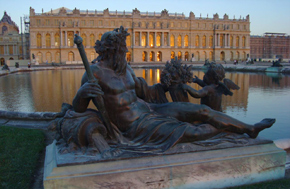
Versailles stands as a monument to the artistry of humanity, as a symbol of absolute political power, and as an instrument of a king's control over his country and court. Versailles also represents the irony of history as we see its role in the downfall of Louis XVI and Marie Antoinette and the destruction of the French monarchy.
Versailles was built originally as a hunting lodge by King Louis XIII, ruling from 1610 to 1643. It was his son, Louis XIV, ruling from 1643 to 1715, who created the splendor that we know as Versailles. Louis XIV became King when he was only 5 years old. In 1661 when he was 23, Louis XIV began to rule in fact as well as in name. Because he wanted to curb the power of the nobles who had rebelled against his rule when he was a child, Louis XIV found that the most effective way to keep them under control was to have them at court.
The royal court was installed at Versailles in 1682, at which time the French nobility was required to live there at least part of the year. Louis XIV used Versailles not only to manage domestic affairs but also to instill awe in foreign visitors by demonstrating the power and riches of the French monarch. The palace and surrounding grounds were designed with infinite detail to exhibit the power of the monarchy. |
|
| |
 











|
|
| Bastille Prison |
| |
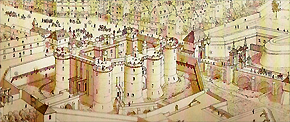
The Bastille was constructed to defend the eastern wall of Paris from hostile forces in 1382. With walls over eighty feet high and well stocked and supplied arsenal, the Bastille quickly gathered the reputation of one of France's most secure military strong points. However, after being besieged seven times and surrendering six of those times, the importance of the fortress diminished. By the early seventeen hundreds it had become a prison.
On May 5, 1789, the King convened the Estates General to hear their complaints, but the assembly of the Third Estate, representing the citizens of the town, soon broke away and formed the National Assembly. On June 20, 1789, the deputies of the Third Estate took an oath "to not separate until the Constitution had been established." The Deputies' opposition was echoed by public opinion. The people of Paris rose up and decided to march on the Bastille, a state prison that symbolized the absolutism and arbitrariness of the Old Regime.
In 1789, when the angry mob broke through the walls and stormed the Bastille they found only seven prisoners inside: four forgers, two lunatics, and a young noble. However, it was not to free the prisoners inside that the battle was fought. Instead, it was to bring down the single most important symbol of the King's power. The Governor of the Bastille had his head cut off and paraded around the streets of Paris on a pike. In the end, eighty-three attackers were dead, and seventy-three injured. The guards only suffered one death and three wounded. |
| |
|
| |
 


|
|
| Temple Prison |
| |
 In the 13th century, Templars began the construction of a new dungeon, best known as the “Tour du Temple”. This dungeon, built in the same fashion as “Caesar’s Tower”, had a square base and was four floors high. In the 13th century, Templars began the construction of a new dungeon, best known as the “Tour du Temple”. This dungeon, built in the same fashion as “Caesar’s Tower”, had a square base and was four floors high.
Each corner was flanked by thick turrets 5 meters across and rising to the upper terrace level. A lookout post, covered by a pyramidal tiled roof, was installed on this level as a fifth floor. The terrace itself was used as a rampart walk and it was protected by a crenellated wall.
Throughout its history the “Tour du Temple” was very often used as a royal prison. At the Tuileries, the royal couple, their two children and the King's sister were given over to the mob after a bloody take over that cost over a thousand their lives. Surrendering to the mob without resistance, they must have known that their fates were sealed. They all were locked in yet another monastery, the Temple Prison that had been seized by the revolutionaries.
It was here that the "Capets" were to reside together prior to the trail and beheading of Louis XVI. It is also the death place of the "Lost Dauphin" (Louis XVII) who died at age 10 after succumbing to tuberculosis.
In 1796, the “Tour du Temple” became a state prison, but the links with regal tragedy defined the tower as a place of pilgrimage for “unconstitutional” royalists. In 1805, the Temple of Paris was actually bought by a royalist and the pilgrimages continued as the story of the unfortunate royal family’s demise continued circulating. Eventually one of Napoleon's ministers completely forbade them from the sale and ordered the demolition of the fortification walls. In an extension of this demolition Napoleon himself ordered the destruction of the “Tour du Temple” by a decree dated 16th March 1808.
The destruction of the tower meant all the ancient templar remnants disappeared, except the Great Prior’s Palace. Between 1805 and 1810 most of the remaining buildings (the church and the towers) disappeared.
|
|
| |







|
|
| Conciergrie Prison |
| |
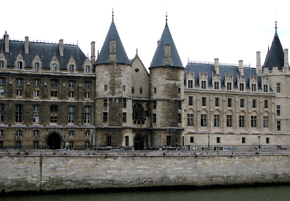
Located on the Cité Island near the Notre Dame Cathedral and the Sainte-Chapelle, the Conciergerie was originally the first palace of the Kings of France. Until the 15th century, the Conciergerie, which was built under the King Philippe Le Bel's reign, belonged to the "Palais de la Cité" where the monarchs lived. The medieval rooms and the "three round towers" of the buildings external façade are the only remains from that period.
When Charles V was a child, he witnesses a murder in that very place. As he became king, he decided to move into the Hotel Saint-Paul and later into the Louvre. The administration that remained in the Palace was under the control of a "Concierge", key figure of the medieval period. The Capetian Palace housed above all the judiciary function and the "Conciergerie" quickly became a prison.
In 1391, it became the first Paris prison. Following the collapse of the monarchy, the revolutionary court, set up by the 1793 Convention, judged its victims. Within two years, more than 2,780 prisoners were sentenced to capital punishment and were detained in the Conciergerie Prison until they left for the Place de la Concorde where they were beheaded. Among them, were figures of the French history, such as the Queen Marie-Antoinette or Robespierre.
Its damp rooms, high vaulted ceilings, dark, vermin-infested cells, were home to "les oubliettes" or “the forgotten ones”. Imprisoned for life, they were left to die in conditions that were ideal for the plague, which struck several times during its murky history.
Its "Salle Saint-Louis" was known as the "Salle des Perdus", the Room of the Doomed. It is through this room that the victims walked to the wagons, waiting to transport them to the Guillotine at Place de la Revolution, the present-day Place de la Concorde.
|
|
| |







|
| |
| |
| |
|





 Even the name seemed to be an oddity. The reference to "tuiles" or roof tiles, which the factories produced for centuries, was located near the present site of the gardens. The great Louis XIV resided at the Tuileries Palace while his chateau, Versailles, was under construction. When he left, the building was abandoned, used only as a theater, until the return of the ill-fated royal family.
Even the name seemed to be an oddity. The reference to "tuiles" or roof tiles, which the factories produced for centuries, was located near the present site of the gardens. The great Louis XIV resided at the Tuileries Palace while his chateau, Versailles, was under construction. When he left, the building was abandoned, used only as a theater, until the return of the ill-fated royal family.  The royal family fled to the General Assembly hall near the Place de la Concorde. The faithful Swiss guards, loyal to the end, defended the palace, unaware that their royal charges had deserted the building. The rabble stormed the doors, massacred the guards, looted the palace and left. The palace and once quiet garden were strewn with over 1,000 corpses. The King himself could not stop the slaughter as he cowered with his family in a room of the Assembly.
The royal family fled to the General Assembly hall near the Place de la Concorde. The faithful Swiss guards, loyal to the end, defended the palace, unaware that their royal charges had deserted the building. The rabble stormed the doors, massacred the guards, looted the palace and left. The palace and once quiet garden were strewn with over 1,000 corpses. The King himself could not stop the slaughter as he cowered with his family in a room of the Assembly. 

 In the 13th century, Templars began the construction of a new dungeon, best known as the “Tour du Temple”. This dungeon, built in the same fashion as “Caesar’s Tower”, had a square base and was four floors high.
In the 13th century, Templars began the construction of a new dungeon, best known as the “Tour du Temple”. This dungeon, built in the same fashion as “Caesar’s Tower”, had a square base and was four floors high.